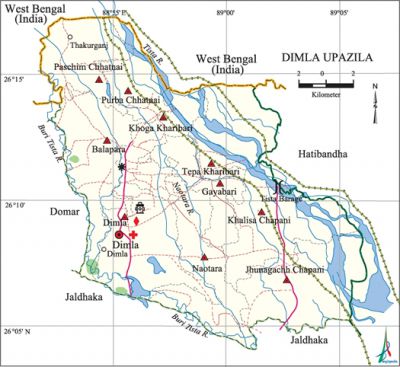Dimla Upazila
Dimla Upazila (nilphamari district) area 326.80 sq km, located in between 26°05' and 26°17' north latitudes and in between 88°52' and 89°06' east longitudes. It is bounded by west bengal of India on the north, jaldhaka upazila on the south, hatibandha upazila on the east and domar upazila on the west.
Population Total 223975; male 114453, female 109522; Muslim 198399, Hindu 25483, Buddhist 13 and others 80.
Water bodies Main rivers: Buri Tista, tista, Naotara.
Administration Dimla Thana was formed in 1857 and it was turned into an upazila on 1 July 1983.'
| Upazila | ||||||||
| Municipality | Union | Mouza | Village | Population | Density (per sq km) | Literacy rate (%) | ||
| Urban | Rural | Urban | Rural | |||||
|
- |
10 |
53 |
53 |
15943 |
208032 |
685 |
44.2 |
35.6 |
| Upazila Town | ||||||||
|
Area (sq km) |
Mouza |
Population |
Density (per sq km) |
Literacy rate (%) | ||||
|
16.14 |
3 |
15943 |
988 |
44.2 | ||||
| Union | ||||
| Name of union and GO code | Area (acre) | Population | Literacy rate (%) | |
| Male | Female | |||
|
Khoga Kharibari 57 |
5810 |
9155 |
8761 |
41.64 |
|
Khalisa Chapani 47 |
10446 |
12568 |
11981 |
34.69 |
|
Gayabari 28 |
5227 |
9206 |
8996 |
40.19 |
|
Jhunagachh Chapani 38 |
11199 |
12945 |
12201 |
28.60 |
|
Tepa Kharibari 95 |
7836 |
7395 |
7268 |
33.13 |
|
Dimla 19 |
10619 |
19730 |
18673 |
42.62 |
|
Naotara 66 |
8707 |
14201 |
13363 |
29.74 |
|
Paschim Chhatnai 76 |
6702 |
9376 |
8327 |
38.07 |
|
Purba Chhatnai 85 |
4472 |
6165 |
6201 |
34.75 |
|
Balapara 9 |
9722 |
13712 |
13151 |
36.54
|
|} Source Bangladesh Population Census 2001, Bangladesh Bureau of Statistics.

Archaeological heritage and relics Dimla Rajbari, Dimla Shiva Mandir.
Historical events During the Tebhaga Movement (1946-47) Tatvanarayan Barman, leader of the movement, was killed in an encounter at the Khamar Bari (farm house) of the local feudal lord Moshiur Rahman Jadu Mia. During the language movement in 1952 Jamshed Ali Chati was arrested for his alleged involvement in the Language Movement and was sent to the Rajshahi Jail. During the war of liberation in 1971 encounters between the freedom fighters and the Pak army were held at Shathibari, Thakurganj, Khoga and Paschim Kharibari.
Marks of the War of Liberation Mass grave 4; memorial monument 1 (Smriti Amlan, Dimla sadar); besides, in memory of Tatnarayan of Tebhaga Movement, 'Tatnarayan Smritistambha' (memorial monument) was built at Dimla Bazar.
Religious institutions Mosque 371, temple 25.
Literacy rate and educational institutions Average literacy 36.2%; male 41.7%, female 30.6%. Educational institutions: college 6, technical college 3, secondary school 48, primary school 352, adult education centre 16, madrasa 102. Noted educational institutions: Dimla Islami Degree College (1983), Dimla Mahila College (1998), Khoga Kharibari High School (1906), Khoga Kharibari Girls' High School (1907), Naotara Abeunnechha High School (1911), Dimla Rani Brindarani Government High School (1917), Hazi Zahartullah High School (1972), Dimla Government Girls' School (1973), Dimla Nijpara Fazil Madrasa (1962).
Cultural organisations Cinema hall 2, theatre group 2, music academy 5, literary society 1, women's organisation 1.
Main sources of income Agriculture 75.36%, non-agricultural labourer 4.92%, industry 0.21%, commerce 8.27%, transport & communication 1.51%, service 3.05%, construction 0.46%, religious service 0.21%, rent & remittance 0.08% and others 5.93%.
Ownership of agricultural land Landowner 57.37%, landless 42.63%; agricultural landowner: urban 49.74% and rural 57.97%.
Main crops Paddy, wheat, corn, potato, tobacco, onion, chilli, vegetables.
Extinct or nearly extinct crops Kaun, sesame, jute.
Main fruits Mango, black berry, jackfruit, guava.
Fisheries, dairies and poultries Dairy 34, poultry 17; besides, there are fish cultivation in 3146 ponds and in a canal of the upazila.
Communication facilities Pucca road 101.42 km, semi-pucca road 10 km, mud road 186.62 km.
Extinct or nearly extinct traditional transport Palanquin, bullock cart.
Noted manufactories Saw mill, rice mill, flour mill, bidi factory.
Cottage industries Blacksmith, potteries, weaving, bamboo work, wood work, tailoring.
Hats, bazars and fairs Hats and bazars are 23, most noted of which are Dimla Babur Hat, Shathibari Hat, Thakurganj Hat, Dangar Hat and Shalhatir Hat.
Main exports Paddy, tobacco, chilli, onion.
Access to electricity All the unions of the upazila are under rural electrification net-work. However 6.93% of the dwellings have access to electricity.'
Natural resources' Stone, sand.
Sources of drinking water Tube-well 78.94%, pond 0.66%, tap 0.54% and others 19.86%.
Sanitation 8.65% (rural 7.35 and urban 25.14%) of dwelling households of the upazila use sanitary latrines and 33.80% (rural 34.80% and urban 21.20%) of dwelling households use non-sanitary latrines; 57.55% of households do not have latrine facilities.
Health centres Upazila health centre 1, satellite clinic 2, family planning centre 10, leprosy treatment centre 1, clinic 1.
NGO activities brac, asa, CARE, Ahsania Mission, RDRS. [Abdus Sattar]
References Bangladesh Population Census 2001, Bangladesh Bureau of Statistics; Cultural survey report of Dimla Upazila 2007.'
